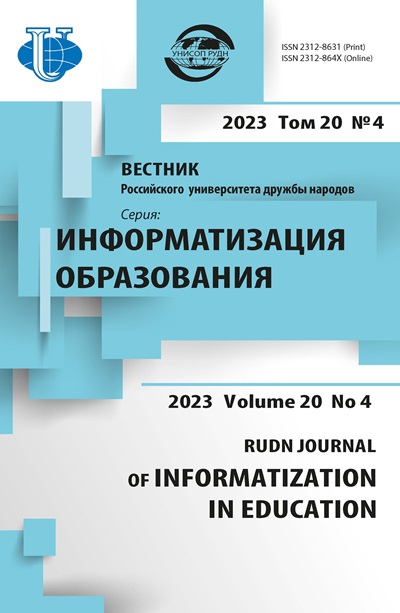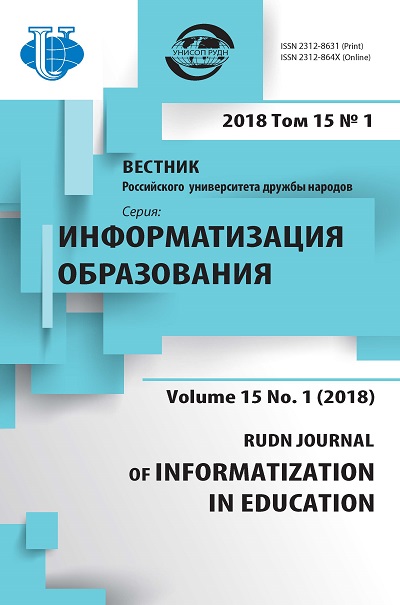Peculiarities of domestic and foreign experience of teachers preparation to training robotics
- Authors: Ionkina N.A.1
-
Affiliations:
- Moscow city pedagogical university
- Issue: Vol 15, No 1 (2018)
- Pages: 114-121
- Section: FOREIGN EXPERIENCE OF INFORMATIZATION OF EDUCATION
- URL: https://journals.rudn.ru/informatization-education/article/view/18059
- DOI: https://doi.org/10.22363/2312-8631-2018-15-1-114-121
Cite item
Full Text
Abstract
Robotics within the subject “Technology” is included in the curriculum of Russian schools. This fact transforms robotics from the subject of additional education into a full-fledged academic subject of the school curriculum. The introduction of robotics into the curriculum of Russian schools requires significant changes in the system of training teachers who will teach students this discipline. Training of teachers for the training of students in robotics is carried out, both in the framework of programs for the preparation of masters in pedagogical universities, and within the framework of various refresher courses. Different countries carry out such training in different ways. In some countries, the training of teachers of robotics is financed by the state, in others by private initiatives. The mission of most foreign educational organizations is to use the motivational effects of robotics to activate schoolchildren and involve them in STEM-education. Many manufacturing companies not only sell robotic equipment, but also prepare methodological and training materials for the implementation of STEM-education technology, as well as create electronic educational resources, training programs, online lessons, evaluation materials and much more. Teaching teachers and schoolchildren, while it is based on the equipment that produces such companies.
Keywords
About the authors
Natalia Aleksandrovna Ionkina
Moscow city pedagogical university
Author for correspondence.
Email: elo4ek@mail.ru
postgraduate of the department of informatization of education Moscow city pedagogical university
Sheremet’evskaja str., 29, Moscow, Russia, 127521References
- Grigor’ev S.G., Grinshkun V.V., Remorenko I.M. «Umnaja auditorija»: ot integracii tehnologij k integracii principov [“Smart audience”: from the integration of technologies to integrate the principles of]. Informatika i obrazovanie [Informatics and education]. 2013. No. 10 (249). Pp. 3—8.
- Grinshkun V.V. Teorija i metodika ispol’zovanija ierarhicheskih struktur v informatizacii obrazovanija [Theory and methodology of using hierarchical structures in Informatization of education]. Informatika i obrazovanie [Informatics and education]. 2003. No. 12. Pp. 117—119.
- Interv’ju s V.S. Gluhovym. Federal’naja innovacionnaja ploshhadka AGRU [Interview with V.S. Glukhov. Federal innovative platform of AGRA]. URL: http://www.agpu.net/fakult/ TEHFAK/Kaf_teh_i_OPD/ssylki/ Fed_inn.asph/ (accessed: 10.08.2017).
- Institut novyh tehnologij [The Institute of new technologies]. URL: http://int-edu.ru (accessed: 1.09.2017).
- Kazahstanskaja associacija robototehniki [Kazakhstan Association of robotics]. URL: http://www. kaar.kz (accessed: 10.10.2017).
- RAOR. Obuchenie. Distancionnye kursy [RAOR. Training. Remote courses]. URL: http://fgosigra.rf//obuchenie/srednyaya-shkola (accessed: 1.09.2017).
- FML 239 [FML 239]. Massovye otkrytye onlajn kursy. Uchiteljam. URL: http://project.239.ru/ mooc (accessed: 20.12.2017).
- Shkola robototehniki [The School of robotics]. URL: http://robolab.by (accessed: 1.09.2017).
- Atwood T. Carnegie Mellon Launches a Mega Million Dollar Robotics Education Initiative // Robot Magazine. 2010. No. 11/12. Pp. 64—70.
- Crea Robotica Educativa. Formaci n a docentes. URL: https://crea-robotica.com/formaciondocentes (accessed: 15.08.2017).
- Flot J., Shoop R. Robotics Research At Carnegie Mellon Robotics Institute. URL: http://www. education.rec.ri.cmu.edu/content/educators/research/files/ WhyRoboticsTEEA (accessed: 15.10.2017).
- Fonds National Suisse. De la Recherche scientifique. Agora — La rencontre entre la science et la soci t. URL: http://www.snf.ch/fr/encouragement/ communication-scientifique/agora/Pages/ default.aspx (accessed: 10.10.2017).
- Liu A., Newsom J., Schunn C., Shoop R. Students Learn Programming Faster Through Robotic Simulation. URL: http://www.education.rec.ri.cmu.edu/ content/educators/research/files/p1619%20Shoop%20et%20al.pdf (accessed: 15.10.2017).
- Paralaxx Inc. Professional Development Courses. URL: https://www.parallax.com/education/ teach/professional-development-courses (accessed: 15.08.2017).
- RoboCity2030.org. Mision. URL: http://www.robocity2030.org/mision (accessed: 10.10.2017).
- Silk E. M. Resources for learning ROBOTS: environments and framings connecting math in robotics. URL: http://www.education.rec.ri.cmu.edu/ content/educators/research/files/ SilkEliM2011.pdf (accessed: 25.08.2017).
- Silk E.M., Schunn C.D. URL: Resources for Learning Robots Facilitating the Incorporation of Mathematical Models in Students’ Engineering Design Strategies (accessed: 25.08.2017).
- Robotics Academy. ROBOTC in China daily Europe. URL: http://education.rec.ri.cmu.edu/ blog/china-daily-europe/ (accessed: 15.10.2017).
















